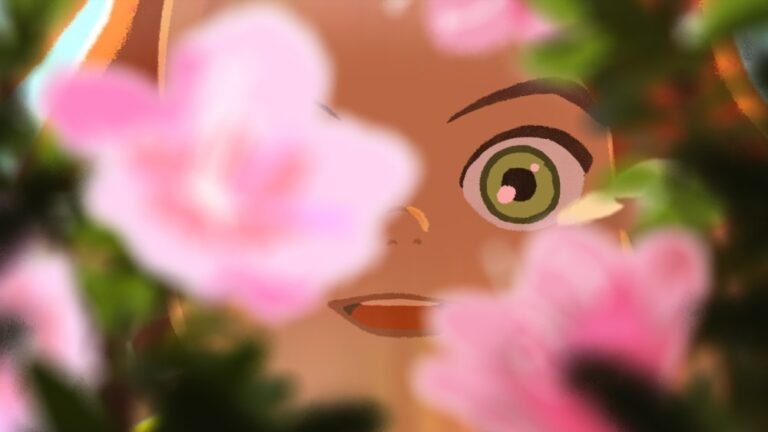The Japan-inclined daughter of a Belgian diplomat, Amélie Nothomb has published several books about her upbringing in Asia, including one in which she boldly channels her inner toddler. In “Métaphysique des tubes” (or “The Character of Rain” in English), Nothomb spends a considerable amount of time thoroughly convinced that she is God. “In the beginning,” opens the memoir, clearly evoking the Good Book. It’s a touch that charmed many in print, but proves tricky to replicate in the otherwise enchanting animated adaptation which premiered at Cannes, delighted Annecy and now finds its way stateside courtesy of Gkids.
As Nothomb remembers it, in those early years, she assumed the universe revolved around her, which makes “Little Amélie” (as the playful toon refers to its big-eyed, bobble-headed title character) a poetic look at the process by which a self-centered European girl born in a foreign land came to understand her place in society. Some of young Amélie’s ideas are quite strange, as when she likens herself to a tube: Food goes in one end and comes out the other. Gross, but easier to accept than the whole God thing (which of course she’ll eventually outgrow).
Where large swaths of the book were dedicated to articulating the mental state of a 2-year-old, the movie embraces a more visual approach, representing the world through Amélie’s eyes. And what captivating eyes they are: hypnotic yellow-green orbs, ringed in emerald! For those keen on surrealistic Belgian reinterpretations of where kids come from, you could find more elegant models in Jaco Van Dormael’s “Toto the Hero” (the movie whose colorful style inspired that other “Amélie”) or “My Life in Pink,” a largely forgotten queer indie ahead of the curve on trans identity.
All of which is to say, “Little Amélie” is hardly alone in offering a fanciful alternative perspective on birds, bees, storks and so forth, though its model can be a wee bit challenging to wrap one’s head around. Is she a deity or is she a tube? Does she possess exceptional powers or just a bratty sense of self-importance? We were all 2 years old at some point, but Amélie’s worldview is neither intuitive nor universal. It’s ultimately via the details that were unique to Nothomb that the movie most engages: being a Westerner in Japan, circa 1970, torn between two cultures, bonding with a local woman without realizing the still-sensitive post-war history.
Filmmakers Maïlys Vallade and Liane-Cho Han, who adapted the book with Aude Py and Eddine Noël, compress little Amélie’s God complex into a short prologue, focusing the bulk of the 78-minute movie on her formative memories. As voiced by Loïse Charpentier, Amélie doesn’t quite know what to make of her own family — especially her bullying older brother André (Isaac Schoumsky) — until her grandmother pays them all a visit from Belgium.
The kindly matriarch wins over Amélie by feeding her white chocolate, and thus a first human connection is made. Soon after, Amélie warms to Nishio-san (Victoria Grobois), the young Japanese woman who works as their housekeeper, forming a bond that serves as the film’s spine. As Amélie gradually learns to make sense of the world — parting the waters of the sea to examine all the creatures living there, and constructing paper lanterns with Nishio for the Obon festival of the dead — the movie works its magic.
In these scenes, audiences are fully aligned with the precocious little girl, whose first word is neither “Mama” nor “Papa,” but “aspirateur” (“vacuum cleaner” in French). Amélie’s parents are understandably impressed when she proceeds to express herself in full sentences, getting revenge on her brother André by speaking everyone’s name but his. It all feels rather twee, until things turn serious and Amélie experiences not one, but two near-death experiences — the way this “god” ultimately comes to appreciate her own mortality, but also convenient opportunities for her to be rescued by characters she’d previously disliked (different from the saviors described in the book).
Co-directors Vallade and Han’s minimalist visual style elegantly matches the young character’s naiveté, forgoing the hand-drawn outlines we expect from anime and vintage toons. Instead, we get fuzzy, slightly pixelated edges that look smoothest on smaller screens. Human faces are represented with as few as four colors, concentrating our attention on Amélie’s intense chartreuse eyes, while simply rendered backgrounds recall the work of artistic collaborator Remi Chayé (who pioneered the look on “Long Way North”) and David Hockney’s late-career iPad paintings. Turns out, all it takes is a few blobs and squiggles to represent a magic-hour garden or trees erupting in cherry blossoms.
The look and feel owes an obvious debt to the beloved films of Studio Ghibli, which have offered some of the most iconic representations of wartime Japan and its long, fraught recovery period. “Little Amélie” starts from a place of (mostly endearing) solipsism and builds empathy and emotional depth as it goes. One scene in particular, in which Nishio-san dramatically prepares dinner while describing the devastation she witnessed, reveals the limits of Amélie’s imagination. Some things are beyond the capacity of a child to understand, while others resonate most profoundly out of the mouths of babes.

